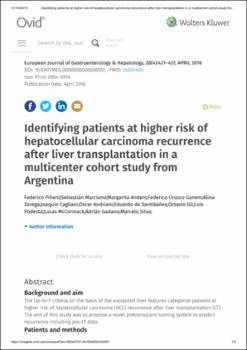Identifying patients at higher risk of hepatocellular carcinoma recurrence after liver transplantation in a multicenter cohort study from Argentina.

View/
Date
2016-04-28Author
Piñero, Federico.
Marciano, Sebastián.
Anders, Margarita.
et al.
Metadata
Show full item recordAbstract
BACKGROUND AND AIM:
The Up-to-7 criteria on the basis of the explanted liver features categorize patients at higher risk of hepatocellular carcinoma (HCC) recurrence after liver transplantation (LT). The aim of this study was to propose a novel pretransplant scoring system to predict recurrence including pre-LT data.
PATIENTS AND METHODS:
From 763 consecutive adult patients who underwent transplantation in four LT centers from Argentina, 124 patients with HCC were included. A scoring system was developed in 87 patients from pre-LT risk factors for recurrence as determined by hazard ratios (HRs) from a multivariate Cox regression analysis.
RESULTS:
Overall survival and recurrence rates at 5 years were 63.3 and 13.7%, respectively, during a follow-up period of 3.5±2.2 years. Variables associated with HCC recurrence on multivariate analysis were α-fetoprotein more than 100 ng/ml (HR=5.6, P=0.001) and tumor beyond Up-to-7 imaging criteria (HR=6.3, P=0.001). Bootstrap validation showed that overfitting was negligible. Scoring points were assigned as follows (0-2 points): pre-LT α-fetoprotein more than 100 ng/ml (presence=1 point, absence=0 point), and tumor beyond Up-to-7 imaging criteria (presence=1 point, absence=0 point). AUROC curve indicated a c-statistic of 0.74 (0.58-0.88, P=0.003). Two distinct subgroups of patients were identified with a cut-off more than or equal to 1 point (62% sensitivity and 82% specificity): low risk (0 point) and high risk (1-2 points). The 5-year recurrence rate was 9.4 and 44.5% (P=0.0001) and the 5-year overall survival was 78.1 and 34.8% (P=0.0001) in the low-risk and high-risk groups, respectively.
CONCLUSION:
This scoring model may be a useful additional tool for HCC recurrence risk stratification before LT. Prospective studies are needed to evaluate our model.

